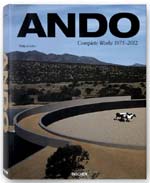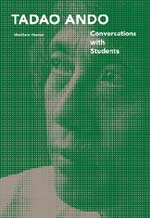
|

|
|
Home Site Search Contact Us Subscribe
|
|
|
Tadao Ando's Thoughtful Heart Two recent books track a trajectory of a spiritual engagement with Modernism. By Norman Weinstein October 24, 2012 Arguably, Tadao Ando’s architectural output of the past 37 years makes him the most significant Japanese architect of our time – a status that he might care a whit about. What two recent books, Ando: Complete Works 1975-2012, by Philip Jodidio (Taschen, 2012), and Tadao Ando: Conversations with Students (Princeton Architectural Press, 2012) suggest is that his career has always been centrally focused upon a ruminative dialogue with the natural world through spiritually-infused design. Being a self-taught architect, Ando created his own curriculum by his early twenties, one with enough breadth and depth to encompass such seeming contraries as boxing and Buddhism! Driven by a curiosity sated only by world travel, spotlighting in his emergent design consciousness the major works of Frank Lloyd Wright, La Corbusier, and Louis Kahn, Ando saw and astutely analyzed Western Modernism through a Japanese spiritual sensibility. The Japanese word “kokora” resists one simple definition in English translation – but it seems to fit Ando well. The psychologist James Hillman’s “Thought of the Heart” phrase perhaps comes closest to describing Ando’s spiritual sensibility realized in design. And while neither of these new Ando books directly clarifies Ando’s quality of kokora, they indirectly, magnificently open a wide range of insights into his singular career.
Tadao Ando: Conversations with Students offers a snapshot of the architect’s thinking aloud surrounded by students at the University of Tokyo’s Graduate School of Architecture in 1998. The book’s title is an annoying misnomer. These are excerpts from five lectures, with only two student questions at the back of this slim volume hinting at any kind of engaging dialogue. Nevertheless, this first English translation, by Matthew Hunter, of Ando’s remarks rewards a close reading. He clearly declares his mission in his first lecture:
“ . . . I became painfully aware of the importance of our memory of landscape. At the same time, I realized once again, the enormous social responsibility my work bears in shaping this memory . . . How can we form places where people can find the hope and courage to live?”
Note the emphasis Ando places on his career modulating between honoring the history encoded in the natural landscape, and creating designed places that are life-affirming in the present and future. To succeed in this balancing act, Ando quickly realized that he would have to tweak Modernism into his distinctive version:
“. . . I became deeply wary of the gap between modernity that symbolized uniformity and homogeneity, and the reality of place, climate, and history . . . By inheriting not merely form, but the hidden spirit within that form (my italics), I wanted to return to architecture a sense of identity and specificity. Through the incorporation of natural elements such as light, wind, and water, I tried to express local climate, features, and culture while simultaneously introducing a contemporaneity and universality using the language and materials of modern architecture and geometric composition.
Put succulently, Ando grounded, aerated, and spiritualized the International Style’s stark concrete and glass minimalism. He evoked the energy of the hidden spirits active in Nature while designing with urban-scaled expanses of concrete and glass. Having never undergone conventional academic architectural training, he hadn’t mastered the “art” of bifurcating technical knowhow from flowering spiritual passion, didn’t split intellect from heart. I wonder what careers unfolded for those Tokyo students treated to Ando’s remarks? Did he promote the proliferation of creative drop-outs by heralding what is so rarely available to would-be architects in schools? In any event, it is salutary to hear Ando thinking aloud about the forces marking his career.
And Jodidio’s Ando: Complete Works 1975-2012 offers an ideal companion to Ando’s lectures. Lavishly packaged with superbly reproduced drawings and photographs of 58 of his major projects, this dense but reasonably sized and priced coffee-table volume also includes thumbnail photos of all Ando completed designs, and a useful biography and bibliography. Jodidio’s analysis is reliably perceptive and succinct. With an apt emphasis on Ando’s Buddhist temples and Christian churches, and with finely detailed photographs that capture the dynamic circulatory pathways into and through his structures, this book justly honors an architect dancing between visible materials and the invisible spirits inhabiting them.
Norman Weinstein writes about architecture and design for Architectural Record, and is the author of “Words That Build” – an exclusive 21-part series published by ArchNewsNow.com – that focuses on the overlooked foundations of architecture: oral and written communication. He consults with architects and engineers interested in communicating more profitably; his webinars are available from ExecSense. He can be reached at nweinstein@q.com.
More by Weinstein:
Albert Barnes Offers
Critical Response to Placement of New "Barnes"
A Meditation on the Beauty of Zaha Hadid's Door Handle Hadid's design issues a challenge: define beauty by lyrically playing with illusion.
Why
"Greatest Hits" Lists by Architecture's Stars Should Be Mocked
Celebratory Meditations on SANAA Winning the Pritzker Prize
Op-Ed: Life After Ada: Reassessing the Utility of
Architectural Criticism
BOOK REVIEWS
"Just Trying to
Do This Jig-Saw Puzzle"
Imperfect Health:
Probing the Porous Interface between Architecture and Health
Book Review:
Advancing Windswept Design: Pointers from Art Nouveau, Zaha Hadid, and Charles
Sowers
Book Review:
Laboratory Architecture for Observing Nature at Play
Book Review: Tracing
a Hidden Track from Adolf Loos as Modernist Architect to Jennifer Post as
Modernist Interior Designer
Two Books to
Accelerate the Translation of Ideas into Practical Forms
Book Review: How to
be a Useful Architectural Critic: Alexandra Lange's Perspicacious Primer Points
the Way
Michael Sorkin:
Architectural Critic as Scam Scanner and Urban(e) Design Sage
Best Architecture
Books of 2011
Book
Review: Pencils that Refuse to Die: Meditations about New Books on
Architectural Drawing
Book
Review: "One Million Acres & No Zoning": Lars Lerup's Outrageous
Encomium to Houston Instructs and Infuriates
Book
Review: Talkin' 'Bout (Not) My Generation: Uplifting Gen X Architects Showcase
Pragmatic Optimism
"Frank
Lloyd Wright's Guggenheim Museum": Bravura Example of an Architectural
Documentary - Wright's Guggenheim Done Right
Book
Review: Diving into Architecture from Every New Angle: Reading Guillevic's
"Geometries"
Book
Review: "Immaterial World: Transparency in Architecture": Marc Kristal
crystallizes increasingly complex notions of transparency with a light touch.
Book
Review: "Visual Planning and the Picuresque" by Nikolaus Pevsner.
Edited by Mathew Aitchison
Book
Review: How New Urbanism's Case Triumphs Best Through "The Language of
Towns & Cities: A Visual Dictionary" by Dhiru A. Thadani
Best
Architecture Books of 2010
Book Review:
"Architecture and Beauty: Conversations with Architects about a Troubled
Relationship": Yael Reisner exuberantly interviews architects about beauty
Book
Review: Shedding Light on Concrete: Tadao Ando: Complete Works 1975-2010 by
Philip Jodidio
Book
Review: Sage Architectural Reflections from Architecture's "Athena": Denise
Scott Brown's "Having Words" distills a lifetime of theorizing and
practice into practical and succinct guidance for thriving through difficult
times
Book
Review: Keeping the Architectural Profession Professional: "Architecture
from the Outside In: Selected Essays by Robert Gutman" celebrates Gutman's
legacy as invaluable outsider
Book
Review: "Design through Dialogue: A Guide for Clients and
Architects," by Karen A. Franck and Teresa von Sommaruga Howard
Twilight Visions: Vintage Surrealist Photography Sheds
New Light on Architecture
Best
Architecture Books of 2009
Book Review: "Gunnar Birkerts: Metaphoric Modernist" by Sven Birkerts and Martin Schwartz A major architect in the history of Modernism finally receives recognition – and sundry asides about why Modernism never exited.
Book Review:
"Urban Design for an Urban Century: Placemaking for People," by Lance
Jay Brown, David Dixon, and Oliver Gillham
Book Review: "Everything
Must Move: 15 Years at Rice School of Architecture 1994-2009"
Book Review: A Subversive Book Every Architect Needs:
"Architect's Essentials of Negotiation" by Ava J. Abramowitz
Book Review: A Perspective from One Elevation: "Conversations With Frank Gehry" by Barbara Isenberg Gehry's conversations offer portraits of an astute listener as well as talker, an architect as aware of his flaws and limitations as of his virtues.
Best Architecture Books of 2008
Book Review: You've Got to Draw the Line Somewhere A review of Drafting Culture: a Social History of Architectural Graphic Standards by George Barnett Johnston
Book Review: "NeoHooDoo: Art for a Forgotten Faith," edited by Franklin Sirmans Sharpen your pencils - and get ready to do a NeoHooDoo shimmy
|
(click on pictures to enlarge) 

|
© 2012 ArchNewsNow.com